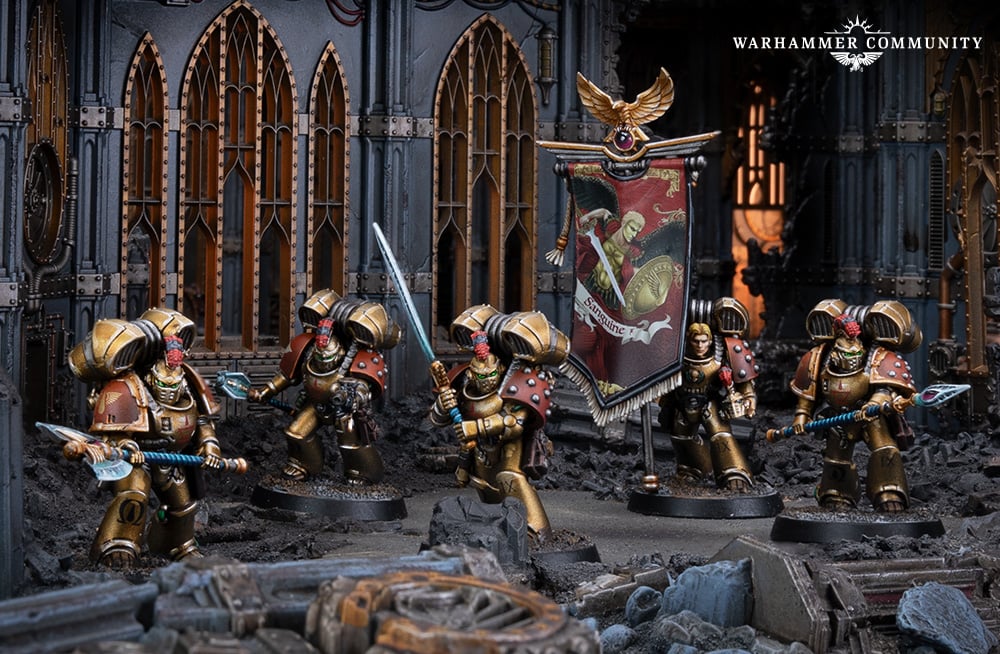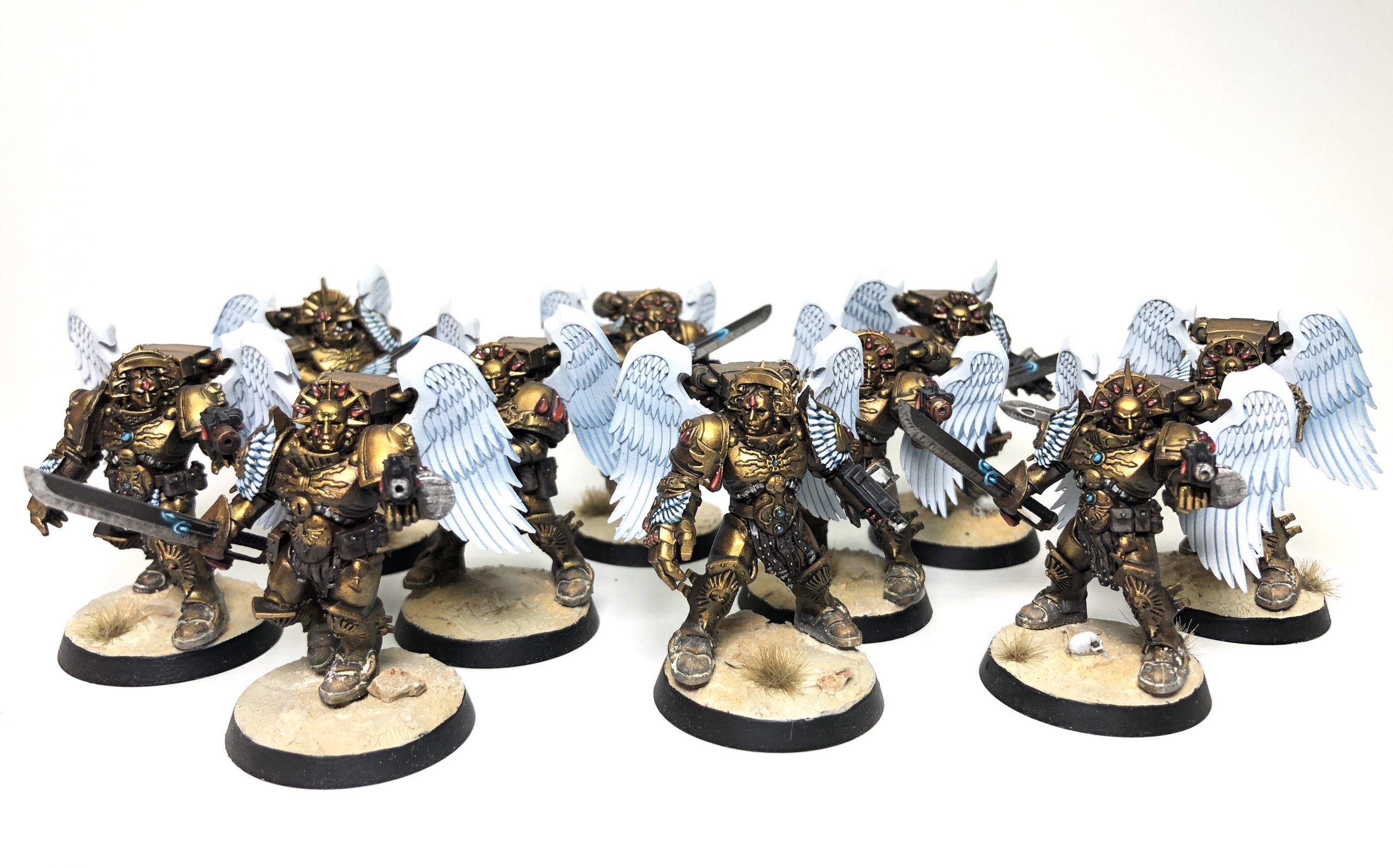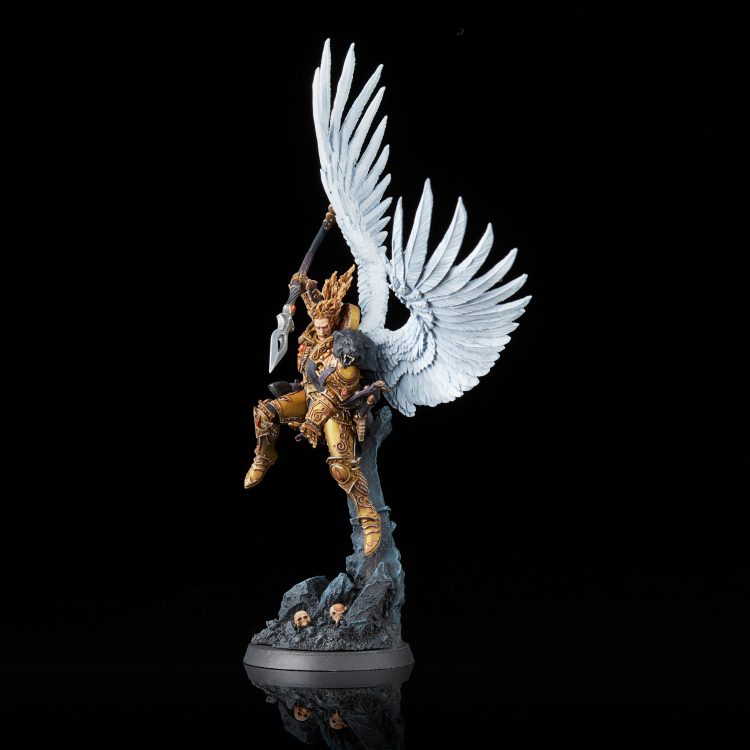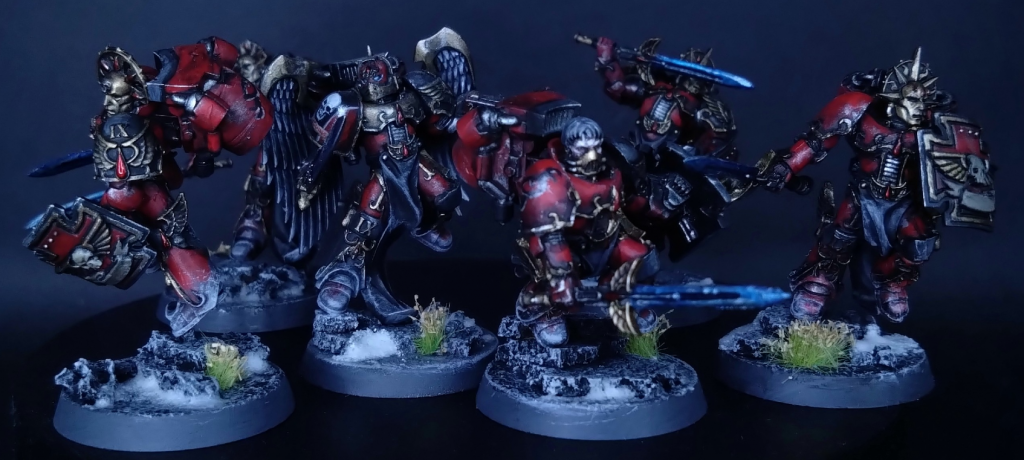An unexpected surprise dropped in on burning wings this week: The Sanguinary Guard finally made an appearance in the world of the Horus Heresy in the new Exemplary Battle Assault on Castrum Velx. For many Blood Angels players these guys have been long-desired, and it seems Games Workshop really went all out with their release – having their own ‘in house’ models, a second version painted up by the wonderful Cult of Paint, and a battle report with the new exemplary mission being run by SN Battle reports!
Let’s join the angelic host, and get a hot take on this new unit. I’ll give a brief overview of their background, speed through the rules (sans judgement), give you my hot takes on the unit, and finally suggest some ways of fielding the squad.

Who Are the Sanguinary Guard?
I’m not going to go too into detail here, but to quickly summarise: The Sanguinary guard (or their older title Ikisat – the Burning Ones) are the personal guard of the Primarch Sanguinius, lord of the Blood Angels. Part of the Great Angel’s First Sphere when a legion veteran is invited to join their ranks, they eschew their former ranks in favour of the single title ‘Seraph,’ and the inviolate duty to obey and protect their liege lord. Throughout the heresy they served Sanguinius with distinction, and on occasion were even attached to other notables of the Blood Angels (though always at the Primarch’s discretion).

The Unit and Rules
The Sanguinary Guard are at base a Legion Command Squad. Ballistic Skill 4, Weapon Skill 5, 2 wounds, 2 attacks, and a 2+ armour save, making them better than line troops, but no better than any other Legion elite. Opening at 210 points you’ll get five of these guys (with the ability to take a further five more at 40pts per model), each equipped with a bolt pistol, a perdition weapon, a jump pack, and the usual grenades. No banner though (we’ll get back to that). The perdition weapons are an unsurprising and solid element to the unit – each one is an upgraded variant of their ‘power’ equivalent (+1 strength more than its equivalent, and Brutal (2), although at the cost of being two handed – so no shields, and no bonus attack). So, for example where a power sword is Rending (6+) AP3, the Blade of Perdition is +1 Strength, Two Handed, Rending (6+), Brutal (2). These explain the high initial cost of the unit – each Perdition weapon is typically the cost of a power weapon +5pts.
For special rules, the Sanguinary Guard are locked as Loyalist only, and are all Chosen Warriors as you would expect, allowing them to prevent their commander or Primarch from being caught in unnecessary challenges. They are also a Support Squad meaning they cannot be used to fulfil a compulsory HQ choice in a list. The squad has two further unique special rules:
- Sanguinary Guard Retinue: The Sanguinary Guard squad may be chosen as a retinue, rather than a squad by themselves, for a Blood Angels model with Master of the Legion in the same detachment. Alongside the normal rules for a retinue (see Liber Astartes) for 15pts one member of the squad may choose to replace their perdition weapon with a Legion Standard and a power weapon (because a Perdition weapon is Two Handed it is technically not possible for the model to use it and the banner at the same time). It’s an understandable upgrade, allowing the squad to gain Line and the effective Leadership of 10.
- The Burning Ones: This rule has two parts. If the unit is part of a detachment that includes Sanguinius, and Sanguinius is on 4 or fewer wounds, they gain +1 Attack. They gain an additional +1 Attack if/when Sanguinius dies. Rules as written, this is an instantaneous effect. If the squad is selected in a detachment without Sanguinius, then all units with a model locked in combat within 6” of at least 2 Sanguinary guards count as having scored +1 wound during combat resolution (although this doesn’t stack with any other combat res increases).
When it comes to upgrades the squad does not have access to the usual selection of melee and firearm upgrades that the generic Legion Command Squad may take. Any Sanguinary Guard may exchange their bolt pistol for a hand flamer, volkite serpenta, plasma pistol, or inferno pistol. One in 5 may exchange their Perdition weapon for a Paragon Blade (for only 10pts), and the entire squad may take Melta Bombs for the usual 25pts.
And that’s it! Short and sweet was certainly the aim of these rules. Let’s get down to the analysis…

Thoughts and Analysis
The first impressions are almost all negative. A high initial cost, having to purchase the banner (so no inherent line), an average ballistic skill, no option for an invulnerable save, and fewer weapons options than a regular Legion Command Squad all immediately jump out at you from the page. And you’d be right: As a direct comparison to a regular command squad, the Sanguinary Guard are a poor equivalent, with distinctly less flexibility on the field.
However, this is wrong. The Sanguinary Guard are both point for point superior at what they are meant to do than a Command Squad, and their rules fit their narrative to an absolute tee.
A regular Legion Command Squad can take jump packs at 10pts per model, and power weapons at 5pts per model. So, for 196pts you have 5 Legionaries with no extra rules. For only 29pts more you have a 5-man Sanguinary Guard squad, that not only do everything the Legion Command Squad does, but also grant +1 combat resolution to the units around them and have better power weapons. Point for point the Sanguinary Guard will be able to take on enemy legion elites and terminators more effectively, either because they can wound them easier, or because Brutal (2) ensures every hit is more likely to cause a wound. Add into this the option to have up to two paragon blades (and up to 10 can take all inferno pistols) and your command squad can really begin to make a dent into enemy death star units. This unit may seem to cost more, but they’ll more than easily kill those points back for you.

As for narrative, this squad are at their best exactly where you would expect them to be – defending Sanguinius. Paragon Blades and Chosen Warriors allow the Guard to step in and remove annoying enemy Praetors and Centurions who could both the Great Angel, whilst their jump packs mean that they can Deepstrike in with him, and not slow him down all too much in the movement. Further to this Sanguinius will be making them effective Weapon Skill 6 on the turn they charge which, when combined with their legion trait and perdition weapons, means there is almost no legion unit in the game they won’t be hitting on 3s and wounding on 2s (enemy debuffs notwithstanding). Add in the benefits of Day of Revelations and the ability to controlled Deepstrike directly onto enemy lines, and you have a rock-solid combat unit that plays super aggressively. The synergy here is what makes the Sanguinary Guard shine, and that matches how they feel in the books to a tee – great warriors alone, but truly superlative when fighting alongside their father.
That doesn’t mean they don’t have limitations though. The unit is balanced in crucial ways. Their high buy-in cost means that you’re only ever going to see a big unit of these with Sanguinius in really high point games, and in most cases at 3,000 points I wouldn’t be surprised to see more than 5. This issue is exacerbated by the intentional lack of invulnerable saves, and the Retinue element meaning that taking a regular Apothecary to protect them is also ruled out. If you want this unit to be survivable and murderous, you’re going to need to spend more points on HQ choices such as Primus Apothecary for them. They are two wounds a piece, but don’t rely on that keeping them alive too long in front of concentrated fire – and if they’re flying around with Sanguinius they most certainly will be taking plenty of that. Because of their fixed jump packs as well, there’s no chance of using a transport to keep them safe from enemy first turn fire, unless you choose to use Deepstrike and run the gauntlet of interceptors.
So, in summary you’re going to need to be tactical with them, but the payoff for doing so is most definitely worth it.

How to Use Them
Based on some immediate analysis (from a primarily narrative player admittedly), here are three possible ways off the top of my head you could use your Sanguinary Guard:
1 – The Sanguinius Bomb
- Day of Revelations
- Sanguinius – 485pts
- 10 Sanguinary Guard (Banner, 10 Inferno Pistols, 2 Paragon Blades) – 545pts
- Primus Medicae (Thunder Hammer, Warhawk Jump Pack) – 155pts
Total: 1185pts
A high price to pay; however, you now have a ten man unit (plus primarch and centurion) deepstriking from turn 2, able to pump out ten Melta shots a turn before charging in with all the beautiful Sanguinary synergy going on and a 5+ Feel No Pain for the unit (or a re-rollable It Will Not Die) for Sanguinius. There isn’t much this lot won’t kill on the charge.
2 – Will It Blend?
- Praetor (Paragon Blade and Warhawk Jump Pack) – 170pts
- Moritat (Inferno Pistols and Warhawk Jump Pack) – 145pts
- 5 Sanguinary Guard (Banner, Inferno Pistols, Mauls of Perdition) – 275pts
Total: 590pts
Are Enemy Mechanicum getting you down? Feel like taking on all the enemy armour you can get your hands on? Well champ, this is for you. Mauls of Perdition are +3 strength, plus rad grenades from the Moritat reducing enemy toughness by 1, plus being a Blood Angel, means there is almost nothing you’ll fail to wound with these guys. AP3 is less delicious, but 15 effective Strength 8, AP3, Brutal (2) attacks on the charge is absolutely worth it.
3 – Living Icons
- Legion Herald (Warhawk Jump Pack) – 125pts
- 10 Sanguinary Guard (2 Paragon Blades) – 430pts
Total: 555pts
A nice and straight forward build that takes advantage of the Herald’s banner of influence, and the Sanguinary Guard’s +1 to combat resolution. Run this unit behind and into existing combats, and allow the various buffing rules to go to town on the units around them. If they don’t win the combat by force of arms, they’ll not be running away any time soon! At their best,alongside at least 2 combat oriented squads.

Credit:The Prince
Conclusion
All in all, the Sanguinary Guard are a well-balanced and clearly thought out unit. They fulfil exactly the role you would expect them to on the field – staunch bodyguards who do best alongside their Primarch. They aren’t ‘must takes’ but are competent at their job.
I’ll certainly be converting a few of my own for the future. Although I’m already shuddering at the magnets needed…
And because my editor demanded a “Hot Take” – have two very personal opinions to boot.
- They should individually be called “Seraph” not Sanguinary Guard. The lore is right there GW.
- This unit could absolutely have waited in favour of a less-loved legion getting a new special unit. And I say that as a Blood Angels player. We already had 4 unique units (including Ofanim), we could have waited.


